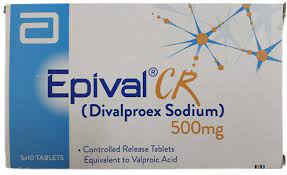
Epival CR is a medication commonly prescribed for the treatment of various conditions such as epilepsy, bipolar disorder, and migraines. It is a controlled-release formulation of divalproex sodium, a compound that helps to stabilize electrical activity in the brain. In this comprehensive guide, we will delve into the details of Epival CR, including its uses, dosage, side effects, precautions, and other important information you should know.
Uses of Epival CR
1. Epilepsy
Epival CR is widely prescribed as an anticonvulsant for the management of epilepsy. It is used to control and prevent various types of seizures, including generalized tonic-clonic seizures, absence seizures, and complex partial seizures. Epilepsy occurs due to abnormal electrical activity in the brain, and Epival CR helps to stabilize this activity, reducing the frequency and severity of seizures.
2. Bipolar Disorder
Epival CR is also utilized in the treatment of bipolar disorder, a mental health condition characterized by extreme mood swings that range from manic episodes (excessive euphoria, high energy) to depressive episodes (persistently low mood, lack of energy). Epival CR helps to stabilize these mood swings by regulating the levels of certain neurotransmitters in the brain, such as serotonin and dopamine.
3. Migraines
In some cases, Epival CR may be prescribed for the prevention of migraines. Migraines are severe headaches often accompanied by other symptoms such as nausea, sensitivity to light and sound, and visual disturbances. The exact mechanism of how Epival CR helps in the prevention of migraines is not fully understood, but it is believed to influence the neurotransmitters and decrease the excitability of the brain.
Dosage and Administration
The dosage of Epival CR will vary depending on the condition being treated, the patient’s age, weight, liver function, and other factors. It is essential to follow your healthcare provider’s instructions and never adjust the dosage without consulting a medical professional.
For epilepsy, the dosage of Epival CR is usually started low and gradually increased to achieve the best seizure control. The initial recommended dose for adults and children over 10 years of age is typically around 10-15 mg/kg/day, divided into two doses. The dosage may be adjusted based on the individual’s response and tolerability, up to a maximum recommended dose of 60 mg/kg/day.
For bipolar disorder, the dosage of Epival CR differs from person to person. It is generally started at a low dose, around 750 mg/day, divided into two or three doses. The dosage is then adjusted based on the individual’s response and may be increased up to a maximum recommended dose of 60 mg/kg/day. It is important to regularly monitor blood levels of the medication to ensure therapeutic levels are achieved.
For migraine prevention, the dosage of Epival CR is usually started at a low dose, around 250 mg/day, and gradually increased based on individual response. The recommended dosage range for migraine prevention is typically 250-1000 mg/day, divided into two doses.
Epival CR tablets are designed to be swallowed whole and should not be crushed or chewed. Taking the medication with food may help to minimize stomach upset, but it is not necessary. Maintaining a consistent dosing schedule is crucial for optimal results.
Precautions and Side Effects
It is important to be aware of the potential precautions and side effects associated with Epival CR usage.
Precautions
- Liver Function: Epival CR can affect liver function, so regular liver function tests should be conducted to monitor for any liver damage.
- Pancreatitis: In rare cases, Epival CR may cause pancreatitis, which is inflammation of the pancreas. Symptoms of pancreatitis include severe abdominal pain, nausea, vomiting, and fever. Immediate medical attention is required if these symptoms occur.
- Pregnancy and Breastfeeding: Epival CR may have harmful effects on fetal development, and it is important to discuss the risks and benefits with your healthcare provider. It may also pass into breast milk, so precautions should be taken while breastfeeding.
Common Side Effects
- Gastrointestinal Symptoms: Epival CR can cause gastrointestinal side effects such as nausea, vomiting, diarrhea, and abdominal pain. Taking the medication with food or dividing the dosage can help minimize these symptoms.
- Weight Gain: Some individuals may experience weight gain while taking Epival CR. Monitoring weight and adopting healthy lifestyle habits are important to manage this side effect.
- Sedation: Epival CR may cause drowsiness or sedation, especially at higher doses. It is important to use caution while operating machinery or driving until you understand how the medication affects you.
Serious Side Effects
In rare cases, Epival CR use has been associated with more serious side effects such as:
- Serious Skin Reactions: Epival CR can rarely cause severe skin reactions, such as Stevens-Johnson syndrome or toxic epidermal necrolysis. These conditions are characterized by a widespread rash, blisters, and skin detachment. Immediate medical attention is necessary if these symptoms occur.
- Blood Disorders: Epival CR may affect blood disorders, leading to symptoms such as easy bruising, unusual bleeding, or signs of infection. Regular blood tests are often conducted to monitor blood counts.
If you experience any of these serious side effects or any new or worsening symptoms while taking Epival CR, it is crucial to seek immediate medical attention.
Conclusion
Epival CR is a medication commonly prescribed for the treatment of epilepsy, bipolar disorder, and migraine prevention. While Epival CR can be highly effective in managing these conditions, it is essential to follow your healthcare provider’s instructions, be aware of potential side effects and precautions, and report any concerning symptoms promptly.
Remember, this guide provides a general overview of Epival CR, and specific dosing and usage instructions should always be obtained from a healthcare professional. It is important to have open and regular communication with your healthcare provider to ensure optimal treatment outcomes and minimize potential risks.




